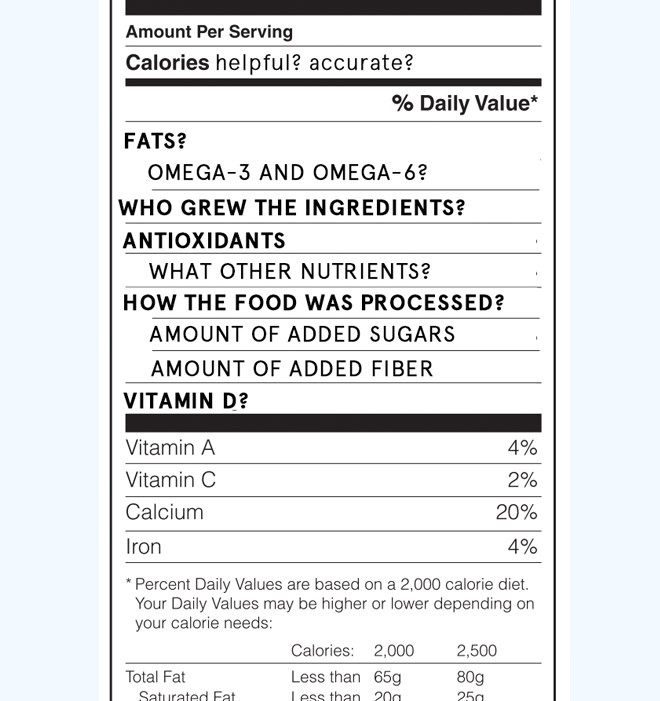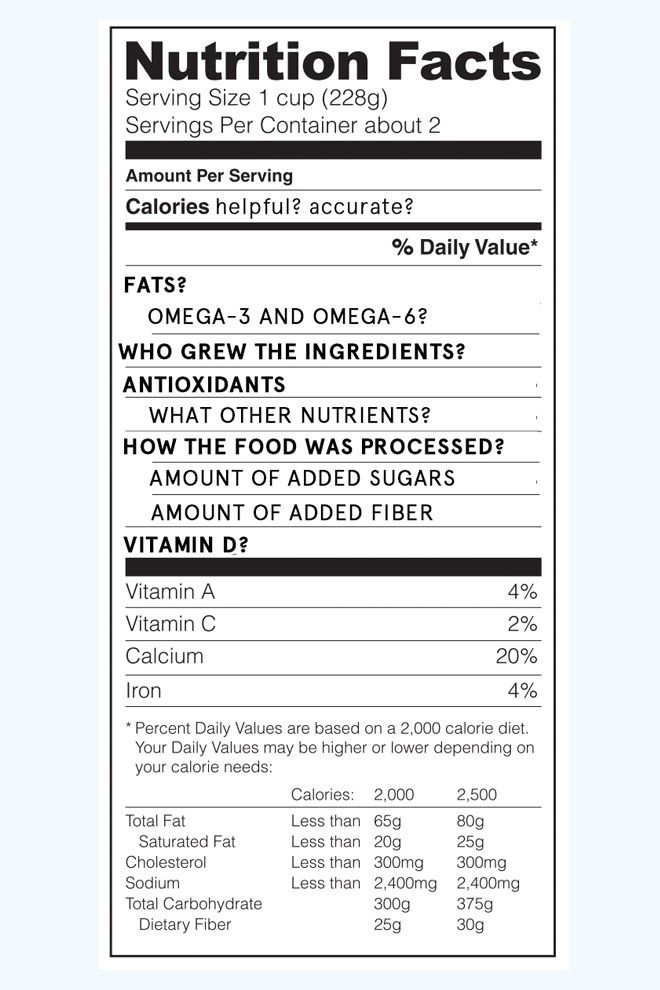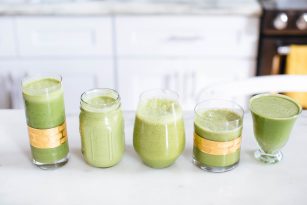First off, thank you for the kind words and support with the new members joining the NS Society yesterday – so happy to have you! You can read more about the healthy meal planning and wellness membership site here. Today’s “The 411” is brought to you by several of your question submissions about things to consider when looking at the back of a food package, i.e. the nutrition label. Keep reading for what a nutrition label doesn’t tell you and how you can best use one to make healthy decisions about the foods you’re eating.
What’s in a label?
As a Dietitian Nutritionist, part of what I do with clients (and with myself during some points in the year) has to do with a lot of numbers, grams of this or that, looking into calories, % of nutrients a day, etc., but my philosophy on living whole and eating well looks at the entire picture. That’s what I practice, teach, and share here with you on the blog because I truly believe this is the golden ticket to feeling our best and achieving a balanced wellbeing. If you’re new to the NS lifestyle or new here in general, first off HIIII, secondly check out my philosophy here for the nitty-gritty. There are so many things we can think about when we look at food and nutrition, but here are my top 5 things I think are missing when we look at the current nutrition label.
No. 01
What about micronutrients, antioxidants, and phytonutrients? Easily enough, when researching a food’s micro and macronutrients in detail, you can simply by using the USDA food database. BUT you also have to know what you’re looking at and looking for, right? It’d be great if someday we could provide data in a quick and easy to read way for everyone to understand how antioxidant and micronutrient rich a food is. Many foods are deficient in vitamin D, so this would be a great addition to the label versus keeping vitamin C on board which we typically get “healthful” amounts of. The amount of both omega-3 and omega-6 are other pieces that would be great to add to the label under the “fat” category.
No. 02
How is the food grown and processed? Let’s say you’re looking at a box of “healthy” crackers. You take a look at the ingredients list (the first place you should always look), and see some ingredients you recognize but mostly ones you don’t. My question to you is how was the food grown? Let’s say one of the cracker ingredients is wheat – well, how was that wheat grown? Is it organic? Is it enriched versus in its whole form? Is it an ingredient that can’t be grown from the ground, i.e. just made in a lab? Be a detective and do your research on the ingredients in your food.
No. 03
What are the added sugars and fibers? Many health foods claim they’re high in fiber, and looking at the nutrition label you may see upwards to 10g fiber per serving on 1 health bar. But is all of this fiber naturally occurring from the ingredients? How much of fiber is coming from the whole foods versus added in such as inulin, a common added fiber. What about added sugars? How many of those grams of sugar are from refined sugars? How many are naturally occurring, such as with fruit? These would be great components to have added on a nutrition label to give us more insight about quantities from natural sources versus added – the ingredient list will help you get a good idea!
No. 04
Who is growing the ingredients in the product (i.e. what country are the ingredients grown in and how)? An example of this practice already used widely is the chocolate and coffee industry. Chocolate and coffee are some of the main food industries that have child labor and poor working conditions. Although I’m just touching the superficial layer about the ethics of the food, I recommend fairtrade and organic whenever possible. Check out this list of chocolates that I recommend. You can read more about this here, here, here, and here.
No. 5
Nutrition labels show us how many servings are in that packaged food you’re holding, what the macronutrient (carbs, fat, protein) profile of it is, and the daily value amounts of iron, vitamin A, calcium, and vitamin D. It’s useful, but how useful is it in the modern day as our food products evolve and how accurate is that information anyways? Do you need to read a nutrition label? If you want to be educated about your food, then YES! Usually that looks like those of you who are consciously tracking your macronutrients and calories, which does help provide accountability and support for weight loss and fat loss goals. BUT for the majority of us who’s goal is simply living well and nourishing our bodies (and not focusing so much on weight loss), we don’t need to live a life of food choices based on a nutrition label. Instead I’d recommend focusing on the ingredient list. I asked friend and fellow Registered Dietitian Nutritionist, Andy Bellatti, MS, RD to share his thoughts about nutrition labels. You might remember him from his interview a few years back. Andy is a pro when it comes to dissecting food policy, covering controversies in nutrition, and is the overall go-to guy for the latest trends in food:
“Food companies stay on top of nutritional trends and see how they can tinker with their current product line to cash in on the hot nutrient of the moment. Some high-fiber breads, for instance, are mostly white flour with added isolated fibers. A 100% whole grain bread may have less fiber, but offers more nutrition by virtue of it being a 100% whole grain product. The front of food packaging is marketing; the back is objective information. Packages of Swedish Fish contain a “fat-free food” call-out on the front. That’s quite meaningless, considering the product is candy and practically 100% added sugar.
One of the latest political food battles has to do with the possible inclusion of “Added Sugar” to the Nutrition Facts label. Currently, “sugar” shows up on one line, and the public has no idea how much of that is added versus naturally occurring. This is important, because added sugar provides empty calories, whereas naturally occurring sugars come bundled with nutrients (this is why snacking on a handful of raisins is not nutritionally equal to snacking on a handful of M&Ms). Most food industry players are staunchly against this move, largely because if added sugar is added to the Nutrition Facts panel, so would a recommendation to consume no more than 50 grams a day. In that case, all consumers would see that a 12 ounce can of regular soda almost offers an entire day’s worth of the recommended maximum.”
How do you read the label?
- Start at the Serving Size and compare that with how many servings are in that package,i.e. Servings per Container. For example: a bottle of kombucha may have 2 servings per bottle and 1 serving is represented on the nutrition label. You’ll need to multiply everything by 2 to get your total numbers for the entire bottle.
- I immediately look to Sugars after the serving size and see how many grams of sugar are in thie food.
- Check the Fiber. I won’t recommend a certain number here since it’s all about the context of the food, but generally I look for about 4g or higher of Fiber per 20g of Carbohydrates.
- Give Calories a look although calories may be inaccurate on the label and not everyone counts these.
- Check ou the Fat. The FDA notes to “limit these” as a whole, although I would say avoid trans fat and limit sodium. We know now that eating fat doesn’t make you fat or cause high cholesterol. In fact, it’s part of a healthful diet.
Ideally, if you’re consuming a whole foods diet you’re not going to be eating that much food that even has a label! Yet it’s incredibly helpful and useful to know your way around an ingredient list and the nutrition label of packaged items. This article from Precision Nutrition was an interesting read as well as this post by Fooducate. On that note, would it be helpful for you guys if I covered all the front of package claims? I’ll be chatting about calories, ingredient labels, food additives, etc. soon because this is another question I get from you guys so often, and I want to make sure I answer “all the things” from my point of view.
Want to learn more about grocery shopping and meal planning? Click to join the NS Society for the ultimate healthy meal planning experience.
xx McKel









